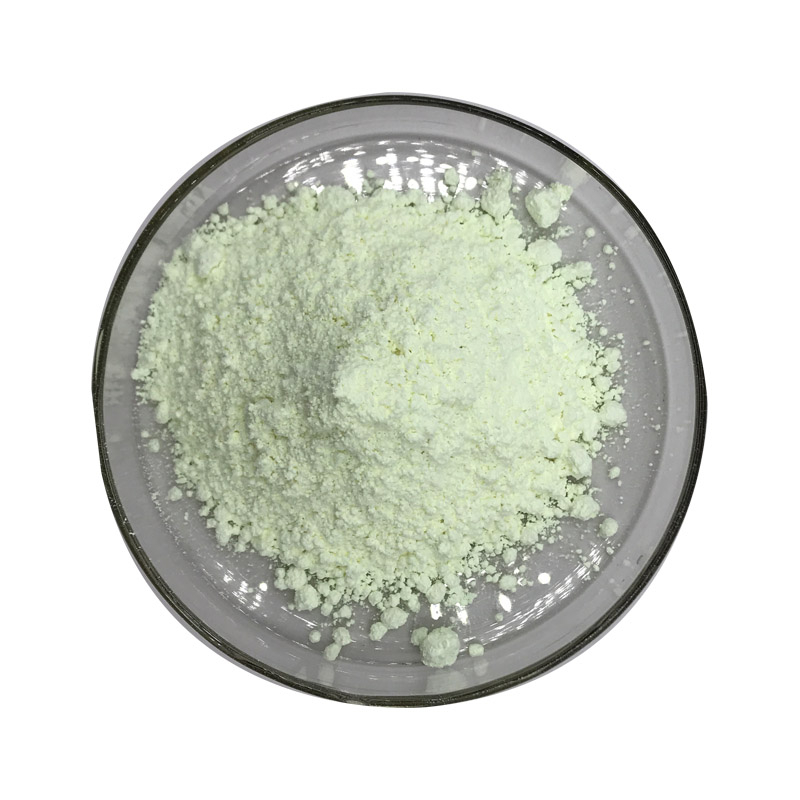Products Description of 1,3-bis(3-glycidoxypropyl)tetramethyldisiloxane CAS#126-80-7Colorless liquid1,3-bis(3-glycidoxypropyl)tetramethyldisiloxane Chemical PropertiesMelting point <0°CBoiling point 184 °C2 mm Hg(lit.)density 0.996 g/mL at 20 °C(lit.)refractive index n20/D 1.452Fp 110°CSpecific Gravity0.996Hydrolytic Sensitivity3: reacts with aqueous baseBRN 223966InChIInChI=1S/C16H34O5Si2/c1-22(2,9-5-7-17-11-15-13-19-15)21-23(3,4)10-6-8-18-12-16-14-20-16/h15-16H,5-14H2,1-4H3InChIKeyMFIBZDZRPYQXOM-UHFFFAOYSA-NSMILES[Si](C)(C)(
Contact Now
Products Description of Diammonium 2,2'-azino-bis(3-ethylbenzothiazoline-6-sulfonate)CAS#30931-67-0ABTS diammonium salt is a substrate for horseradish peroxidase (HRP).Diammonium 2,2'-azino-bis(3-ethylbenzothiazoline-6-sulfonate) Chemical PropertiesMelting point >181oC (dec.)storage temp. 2-8°Csolubility H2O: 50 mg/mL, very slightly hazy, greenform tabletcolor Pale Green to Light GreenPHpH(50g/l, 25℃) : 5.0~6.0Water Solubility Dissolve in water at 50mg/ml.
Contact Now
Products Description of 1,4-Bis-[4-(3-acryloyloxypropyloxy)benzoyloxy]-2-methylbenzeneCAS#174063-87-71,4-Bis-[4-(3-acryloxypropoxy)benzoyloxy]-2-methylbenzene can be used in the field of photography to synthesize fast-erasable dyes, filter materials, charge transfer agents, etc.1,4-Bis-[4-(3-acryloyloxypropyloxy)benzoyloxy]-2-methylbenzene Chemical PropertiesBoiling point 733.5±60.0 °C(Predicted)density 1.219vapor pressure 0.003Pa at 25℃storage temp. Keep in dark place,Sealed in dry,Room Temperatureform powdercolor WhiteWater Solubility 5.3μg/L at 20℃Log
Contact Now
Products Description of 2,4-Bis(phenylsulfonyl)phenol CAS#177325-75-6White powder2,4-Bis(phenylsulfonyl)phenol Chemical PropertiesMelting point 158 °CBoiling point 631.4±50.0 °C(Predicted)density 1.415±0.06 g/cm3(Predicted)pka4.17±0.43(Predicted)form powder to crystalcolor White to Almost whiteCAS DataBase Reference177325-75-6Factory and Equipment ShowFast delivery timeInventory 2-3 working days New production 7-10 working days
Contact Now
(2-hydroxytrimethylene)bis(trimethylammonium) dichloride Chemical PropertiesMelting point 256-257 °C (decomp)Factory and Equipment ShowFast delivery timeInventory 2-3 working days New production 7-10 working days
Contact Now
Products Description of diisooctyl 2,2'-[(dioctylstannylene)bis(thio)]diacetateCAS#26401-97-8Mainly used in PVC products that come into contact with food and medicine, such as plates, sheets, films, etc., and can be used in processes such as calendering, blow molding, extrusion, injection, etc.diisooctyl 2,2'-[(dioctylstannylene)bis(thio)]diacetate Chemical Propertiesdensity 1.08[at 20℃]vapor pressure 0Pa at 25℃storage temp. Refrigerator, under inert atmospheresolubility Chloroform (Slightly), Ethyl Acetate (Slightly)form Oilcolor ColourlessWater Solu
Contact Now
Products Description of 2,2'-[(1-Methylethylidene)bis[(dibromo-4,1-phenylene)oxymethylene]]bis[oxirane]-4,4'-(1-methylethylidene)bis[2,6-dibromophenol] copolymer CAS#68928-70-1Tetrabromobisphenol A-tetrabromobisphenol A glycidyl ether copolymer is widely used in flame retardant potting materials, flame retardant laminate adhesives, etc.
Contact Now
Products Description of Bisphenol-A bis CAS#5945-33-5Bisphenol A Bis(diphenyl phosphate) is a flame retardant.
Contact Now
Products Description of 3,5-Bis-tert-butylsalicylic acid CAS#19715-19-6This product is white powder.
Contact Now
Cyclohexanol, 4,4-(1-methylethylidene)bis-, polymer with (chloromethyl)oxirane CAS#30583-72-3Hydrogenated bisphenol A epoxy resin is mainly used in insulating materials.Cyclohexanol, 4,4-(1-methylethylidene)bis-, polymer with (chloromethyl)oxirane Chemical Propertiesdensity 1.135[at 20℃]vapor pressure 0.002Pa at 20℃Water Solubility 58.6mg/L at 30℃InChIInChI=1S/C15H28O2.C3H5ClO/c1-15(2,11-3-7-13(16)8-4-11)12-5-9-14(17)10-6-12;4-1-3-2-5-3/h11-14,16-17H,3-10H2,1-2H3;3H,1-2H2InChIKeyCSSRVVKVKAJYLJ-UHFFFAOYSA-NSMILESC(C1CCC(O)CC1)(C1CCC(O)CC1)(C)C.C(C1OC1)ClLogP3.84 at 20℃EPA Substan
Contact Now
Products Description of BIS(2-METHOXYETHOXY)METHANE CAS#4431-83-8The molecular formula of bis(2-methoxyethoxy)methane is C7H16O4 and its molecular weight is 164.1995.BIS(2-METHOXYETHOXY)METHANE Chemical PropertiesBoiling point 60°C 1,5mmdensity 0,995 g/cm3vapor pressure 22Pa at 25℃refractive index 1.4140Fp 60°C/1.5mmform liquidcolor ColourlessWater Solubility Fully miscible in water.BRN 1700087LogP-0.69 at 22℃EPA Substance Registry System2,5,7,10-Tetraoxaundecane (4431-83-8)Safety InformationSafety Statements 24/25HS Code 2909199090Pr
Contact Now
Products Description of 1,2-Bis(2-chloroethoxy)ethane CAS#112-26-51,2-Bis(2-chloroethoxy)ethane is a transparent to slightly yellow liquid at room temperature and pressure, and is insoluble in water. It is often used as a material chemical intermediate and a reaction solvent in organic chemical reactions.
Contact Now
Products Description of Cobalt bis(2-ethylhexanoate)CAS#136-52-7Purple liquid.Cobalt bis(2-ethylhexanoate) Chemical Propertiesdensity 1.002 g/mL at 25 °Cvapor pressure 5Pa at 25℃Fp 104 °Fform liquidcolor purpleWater Solubility 40.3g/L at 20℃CAS DataBase Reference136-52-7(CAS DataBase Reference)EPA Substance Registry SystemHexanoic acid, 2-ethyl-, cobalt(2+) salt (136-52-7)Safety InformationHazard Codes Xn,NRisk Statements 10-36/37/38-40-43-66-65-62-50/53Safety Statements 26-36/37-62-61RIDADR UN 1268 3/PG 3WGK Germany&nb
Contact Now
Products Description of Bis-phosphonic acid tetrasodium salt CAS#3794-83-0This product is a brown-yellow viscous liquid. Relative density (20°C) 1.40. Pure product melting point 198-199°C, soluble in water and ethanol.
Contact Now
Products Description of OBSH CAS#80-51-34,4'-Oxobenzenesulfonylhydrazide, also known as bis(benzenesulfonylhydrazide) ether, is an organic compound with the chemical formula C12H14N4O5S2.
Contact Now
Products Description of Bis(2-ethylhexyl) phosphate CAS#298-07-7 Di(2-ethylhexyl) phosphate is a chemical substance. It is a viscous oily liquid with strong acidity.
Contact Now
Products Description of BIS(2-Methacryloxyethyl)phosphate CAS#32435-46-4 BIS(2-METHACRYLOXYETHYL) PHOSPHATE Chemical PropertiesBoiling point 221 °C(lit.)density 1.28 g/mL at 25 °C(lit.)refractive index n20/D 1.47(lit.)Fp >230 °Fstorage temp. 2-8°Cpka1.29±0.50(Predicted)EPA Substance Registry System2-Propenoic acid, 2-methyl-, phosphinicobis(oxy-2,1-ethanediyl) ester (32435-46-4)Safety InformationHazard Codes XiRisk Statements 36/37/38Safety Statements 26-36WGK Germany 3HS Code 29199000Product Applicati
Contact Now
Products Description of Triethylene glycol bis(2-ethylhexanoate) CAS#94-28-0This product is a solvent-based cold-resistant and environmentally friendly plasticizer with excellent low-temperature resistance, durability, oil resistance, UV resistance and antistatic properties, and has low viscosity and certain lubricity. This product is a special plasticizer for polyvinyl butyral (PVB safety glass) and synthetic rubber, which can make them produce low-temperature performance and low volatility. It can also be used for polyester cloth, adhesives and sealing materials.
Contact Now
Products Description of Bis(2-ethylhexyl) maleate CAS#142-16-5Diethylhexyl maleate, also known as diisooctyl maleate, is a chemical with the molecular formula C20H36O4.Bis(2-ethylhexyl) maleate Chemical PropertiesMelting point -50°CBoiling point 208-209°C 10mmdensity 0.944 g/mL at 25 °C(lit.)vapor pressure 0Pa at 20℃refractive index n20/D 1.455(lit.)Fp >230 °Fstorage temp. Sealed in dry,Room Temperaturesolubility Chloroform (Sparingly), Ethyl Acetate(Slightly),Methanol (Slightly)form Liquidcolor ColourlessWater
Contact Now
Products Description of Dioctyl sebacate CAS#122-62-3Dioctyl sebacate, also known as bis-2-ethylhexyl sebacate, referred to as DOS, is made by esterification of sebacic acid and 2-ethylhexanol. It is suitable for polyvinyl chloride, vinyl chloride copolymers, nitrocellulose, ethyl cellulose and synthetic rubber. It has high plasticizing efficiency and low volatility. It has excellent cold resistance, good heat resistance, light resistance and electrical insulation. It also has good lubricity when heated, making the product look good and feel good.
Contact Now
BIS(2-METHACRYLOXYETHYL) PHOSPHATE Chemical PropertiesBoiling point 221 °C(lit.)density 1.28 g/mL at 25 °C(lit.)refractive index n20/D 1.47(lit.)Fp >230 °Fstorage temp. 2-8°Cpka1.29±0.50(Predicted)EPA Substance Registry System2-Propenoic acid, 2-methyl-, phosphinicobis(oxy-2,1-ethanediyl) ester (32435-46-4)Safety InformationHazard Codes XiRisk Statements 36/37/38Safety Statements 26-36WGK Germany 3HS Code 29199000Product Application of BIS(2-METHACRYLOXYETHYL) PHOSPHATE CAS#32435-46-4 Used in resin and
Contact Now
Products Description of 1.1'-Binaphthyl-2.2'-diphemyl phosphine CAS#98327-87-81,1'-Binaphthyl-2,2'-bis(diphenylphosphine) (BINAP) is a powerful chiral auxiliary used as a homogeneous catalyst in certain asymmetric chemical syntheses.
Contact Now
Products Description of Hexafluorobisphenol A CAS#1478-61-1Bisphenol AF is also known as hexafluorobisphenol A, 2,2-bis(4-hydroxyphenyl)hexafluoropropane, 2,2-bis(4-hydroxyphenyl)hexafluoropropane, etc., referred to as BPAF. It is slightly soluble in carbon tetrachloride, difficult to dissolve in water, and easily soluble in organic solvents such as ethanol, acetone, ether, toluene, and strong alkaline solutions.
Contact Now
Products Description of Hexafluorobisphenol A CAS#1478-61-1Bisphenol AF is also known as hexafluorobisphenol A, 2,2-bis(4-hydroxyphenyl)hexafluoropropane, 2,2-bis(4-hydroxyphenyl)hexafluoropropane, etc., referred to as BPAF. It is slightly soluble in carbon tetrachloride, hardly soluble in water, and easily soluble in organic solvents such as ethanol, acetone, ether, toluene and strong alkali solutions.
Contact Now




![1,4-Bis-[4-(3-acryloyloxypropyloxy)benzoyloxy]-2-methylbenzeneCAS#174063-87-7](https://d3rnfhc14zcmdf.cloudfront.net/cdn/ff/UzaxHqC7dqMBX0gCNrVwnr0zZlxBJGLCf_1pR8RV7U8/1719438243/public/styles/chanpinzhutu/public/2024-06/%E7%99%BD%E8%89%B2%E7%B2%89%E6%9C%AB%20%285%29_15.jpg?itok=9zTdC24L)


![diisooctyl 2,2'-[(dioctylstannylene)bis(thio)]diacetateCAS#26401-97-8](https://d3rnfhc14zcmdf.cloudfront.net/cdn/ff/MEIXbra4wyUKJKW67w9UkqzwQzIZQBAtmtXt1eQRqFc/1718820022/public/styles/chanpinzhutu/public/2024-06/%E6%97%A0%E8%89%B2%E6%B6%B2%E4%BD%93%20%283%29%20-%20%E5%89%AF%E6%9C%AC_41.jpg?itok=btFpy9ph)
![2,2'-[(1-Methylethylidene)bis[(dibromo-4,1-phenylene)oxymethylene]]bis[oxirane]-4,4'-(1-methylethylidene)bis[2,6-dibromophenol] copolymer CAS#68928-70-1](https://d3rnfhc14zcmdf.cloudfront.net/cdn/ff/4aHmJfFwYpEABMbnR7HTG1yocAzE1PHApY-zrZ-DCjo/1717752361/public/styles/chanpinzhutu/public/2024-06/%E6%97%A0%E8%89%B2%E6%B6%B2%E4%BD%93%20%283%29%20-%20%E5%89%AF%E6%9C%AC_5.jpg?itok=G1rPjRBd)

























